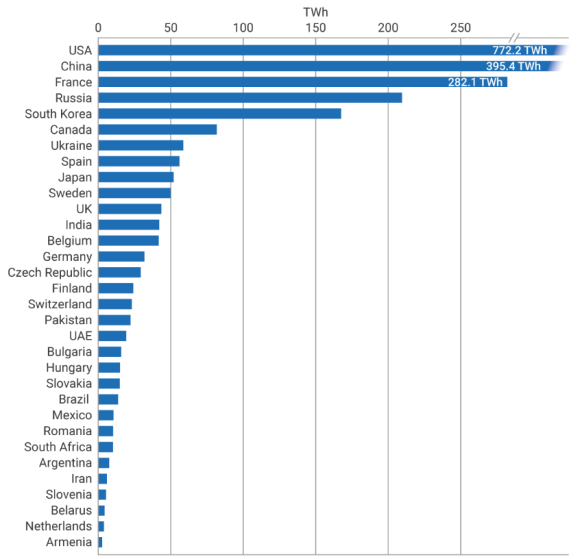Nuclear industry pledges to triple capacity by 2050
Nuclear power advocates at the COP28 conference vowed to triple global nuclear capacity by 2050, an ambitious target amid changing attitudes.

Related Articles
In a joint statement signed by 22 countries and backed by 120 companies, the ‘Declaration to Triple Nuclear Energy’ called on world leaders to work together to achieve the goal seen as necessary to reach net zero by 2050 in studies by the OECD Nuclear Energy Agency (NEA) and the World Nuclear Association.
Global nuclear power capacity currently stands at almost 400 GW generated by 438 reactors. Increasing that capacity to over a terawatt in the next couple of decades will involve the construction of hundreds of new reactors, a proposal that would have been unthinkable at a climate conference like COP just a couple of years ago.
Nuclear, traditionally, has struggled for representation at environmental conferences such as COP28, or the 28th Conference of the Parties to the original 1992 United Nations Framework Convention on Climate Change.
At previous COPs, nuclear has been jokingly referred to as the ‘N-word' and pro-nuclear activists have been shunned. During the 2018 COP24 in Poland, nuclear supporters dressed as polar bears were forced to leave climate marches by police after organizers requested they be removed.
“We very much felt that we were defending the indefensible,” says Jadwiga Najder, coordinator for the grassroots initiative Nuclear for Climate.
However, nuclear power has gained acceptance in recent years, especially amongst young environmentalists, says Najder.
“We've seen amazing crowds of people coming from many different countries and from many types of economies. Year by year, it seems that this negativity and strong opposition has developed into curiosity and an agreement that we need to know more in order to be able to really make up our minds.”
Nuclear generation by country 2022
(Click to enlarge)
Source: International Atomic Energy Agency
High aspirations
To meet the COP28 Declaration goal, the world will need to add around 30 GW of new nuclear, or the equivalent of more than nine Hinkley Point C-sized power plants, every year between now and 2050.
Globally, there are currently 62 reactors under construction, 26 of which are in China and another eight in the next most active nuclear build country, India, with a total capacity of just under 70 GW, according to World Nuclear Association figures.
Another 111 are planned, with a total capacity of 108 GW (42 in China and 25 in Russia), and another 318 proposed worldwide, with a capacity of 353 GW, almost half of which are in China.
Assuming all these projects are completed as proposed – a distant possibility considering present build rates – that makes up just 20 GW a year on average, well short of the final goal.
“That is the type of growth we need to see to reach the climate goals and that’s the direction governments need to set. They need to be saying this is where we need to go,” says Director of Energy Transition Practice at energy market consultancy Wood Mackenzie David Brown.
Goals such as these helps guide investors and companies to direct the necessary capital in the right direction and, while the energy industry has a strong track record of innovation, the world needs to think differently and reframe the debate about where it produces its energy.
“I think it's a very positive sign that it's a clear statement of intent around the direction of where investment should go over time” says Brown.
The silver lining of Russia’s war with Ukraine and the global challenges around reaching climate targets is that there is renewed focus on the work that must be done if we are to achieve the goals of the Paris agreement, he says.
No short-term fix
Recent stalled attempts to kickstart Gen IV nuclear technology in the United States have some claiming that state-of-the-art technology may not bring the short-term fix to the industry that many had been hoping for.
While the Nuclear Innovation Alliance (NIA) applauded the goal of tripling capacity, which it noted was broader and more ambitious than its own call to double capacity, its Executive Director Judi Greenwald says that there are real and difficult challenges that must be addressed within the nuclear industry.
These include advanced reactor project costs and project execution, customer willingness to invest in first-mover and fast-follower advanced nuclear energy projects, recognition of the clean energy benefits of advanced nuclear energy, and ensuring the safe and responsible deployment of advanced nuclear energy through effective and efficient regulation.
“We don’t believe those challenges are insurmountable, but they will take a whole-of-society effort to address,” says Greenwald.
"We acknowledge that developing advanced nuclear energy will be – and is – difficult. But we don’t have a choice: we need this and all solutions to be effectively, efficiently, and safely developed as quickly as possible to specifically address the real and present danger of a changing climate."
By Paul Day

